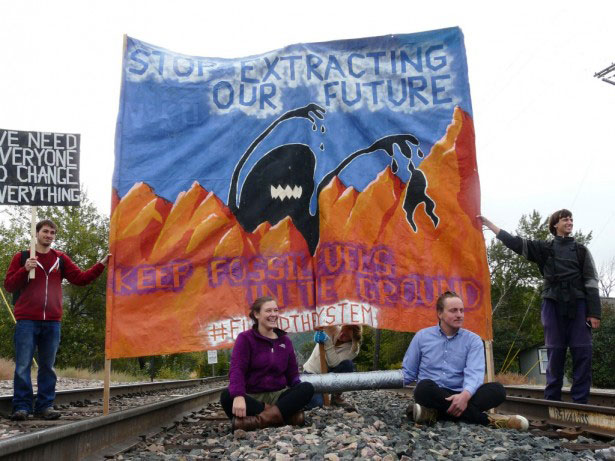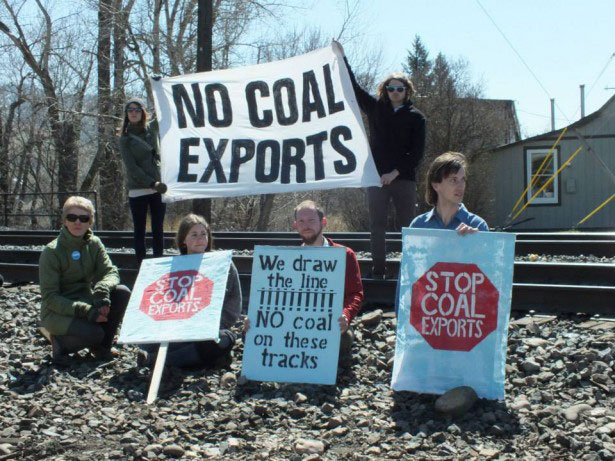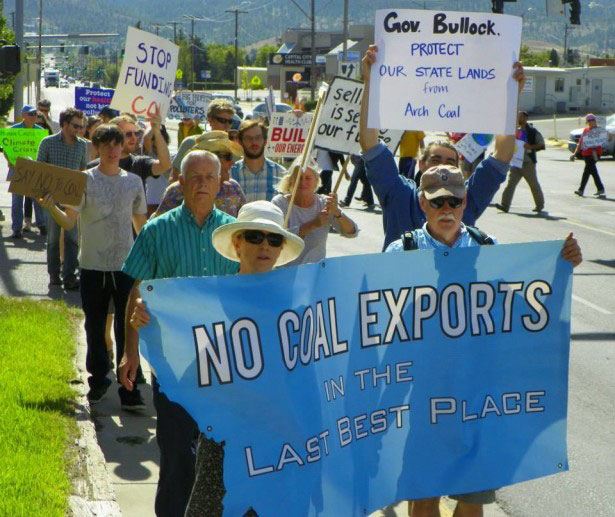
Support justice-driven, accurate and transparent news — make a quick donation to Truthout today!
Montana communities won a victory against one of the world’s biggest coal companies earlier in March, when Arch Coal abandoned the Otter Creek mine — the largest proposed new coal strip mine in North America. The story of how the project imploded is one of people power triumphing over a company once thought to be nearly invincible.
To many observers, the Otter Creek project once seemed unstoppable. It certainly appeared that way in 2011, the year I moved to Missoula, Montana for graduate school. Then-Democratic Gov. Brian Schweitzer enthusiastically supported the mine, and coal more generally. Forrest Mars, Jr., the billionaire heir to the Mars candy fortune, had just joined Arch and BNSF Railways in backing a proposed railroad spur meant to service Otter Creek. Arch and politicians like Schweitzer predicted a boom in coal demand from economies in Asia.
But what they weren’t counting on was a vocal and active region-wide opposition. The coming together of ordinary people — first in southeast Montana, then an ever-growing number of communities throughout the Northwest — to oppose the Otter Creek mine says much about how land defenders and climate activists are learning to fight back against the planet’s biggest energy companies. The roots of this recent victory go back more than 30 years.
Origins of the Otter Creek Mine
Eastern Montana is known for its arid climate, but the Tongue River Valley just north of the Wyoming border supports a lush landscape of willows, pines, sagebrush and grassy pastures. The river and underground aquifers make the valley ideal for agriculture. On the east side of the river, where the Otter Creek tracts are located, a mix of state and private land supports farms and cattle ranches. To the west is the Northern Cheyenne Reservation.
Decades before Arch proposed the Otter Creek mine, Southeast Montana was already ground zero in a fight over the nation’s energy future. In 1971, as the United States looked for alternatives to foreign oil, the Bureau of Land Management published a study calling for massively increased coal production in northern Plains states. It proposed building 21 new coal-fired power plants in Montana and opening vast new mines to feed them. Implicit was the assumption that energy developers would run into little resistance in the sparsely populated Plains.
Corporate representatives tried to persuade ranching families to sell their land for mines, then threatened them with eminent domain. However, many landowners didn’t back down. “I told that son-of-a-bitch with a briefcase that I knew he represented one of the biggest coal companies and he was backed by one of the richest industries in the world, but no matter how much money they came up with, they would always be $4.60 short of the price of my ranch,” said landowner Boyd Charter, according to Northern Plains Resource Council, an organization that formed in 1972 to oppose the mining. By the end of the decade only one major new coal plant had broken ground in Montana, and plans to turn the state into a large-scale coal sacrifice zone were in tatters.
Then, in the 1980s, the coal industry proposed a new Tongue River Railroad to link northern Wyoming coal fields to existing Montana rail lines. The plan floundered for decades amid local opposition, but in 2011 the Tongue River Company was bought up by Arch Coal, BNSF Railways and Forrest Mars, Jr. Mars, who owns a private ranch in area, formerly opposed the railroad but apparently bought in with the understanding that the preferred route would be shortened to not cross his property. Instead of hauling Wyoming coal, this new version of the Tongue River Railroad would service Arch’s Otter Creek mine. The coal industry would try again to turn Montana into a coal extraction colony.
Their plan was helped along the previous year, in March 2010, when the Montana State Land Board, chaired by Gov. Schweitzer, voted on whether to lease state lands at Otter Creek to Arch. Ranchers concerned about damage to aquifers, high school students worried about climate change and other concerned citizens at the meeting urged the board to vote no. Just before the vote, activists from Northern Rockies Rising Tide disrupted proceedings by chaining themselves to Land Board members’ desks. The protest drew attention to what was at stake. But Land Board members reconvened and voted 3-2 in favor of the lease.
Now all Arch needed to break ground was a mining permit from the state, and a permit to build the Tongue River Railroad from the U.S. Surface Transportation Board. The battle lines were drawn.
From Tongue River to the Coast
What happened at Otter Creek would affect communities throughout the Pacific Northwest. Coal train traffic through the area was already up, hauling coal from existing Wyoming and Montana mines to British Columbia ports. If Otter Creek and a series of proposed new coal export terminals in the United States were built, the number of these trains would skyrocket.
“I noticed more and more coal trains rumbling past my home,” said Lowell Chandler, who was a senior at the University of Montana and lived next to the railroad in Missoula when I met him in 2011. “They were polluting my air with toxic diesel emissions and coal dust. Then I found out about the massive coal export proposals in my state and the Northwest region.”
In places like Missoula, disproportionately lower-income neighborhoods are directly across the street from the railroad. An industrial yard used to refuel trains and connect and reconnect train cars is a major source of pollution. Residents told of sounds like bombs going off in the middle of the night as rail cars were joined together, of coal dust on their windowsills, and of choking on diesel fumes from idling locomotives.
I joined Chandler and other UM students in starting a group called Blue Skies Campaign in 2011, to work in coordination with rail line neighborhood residents and push back against the coal trains. Blue Skies’ first action was a protest outside a Wells Fargo, at the time a major coal industry funder. Later we partnered with Northern Plains Resource Council and other groups on a coal trains forum that drew over 200 people. We organized to attend city council meetings, coordinated rallies, and held street theater and protests. But we knew we had to do more.
In August 2012, Blue Skies coordinated the largest energy-related nonviolent civil disobedience in Montana up to that time. The Coal Export Action, a five-day sit-in at the State Capitol, was a protest against leasing of state lands to coal companies. Twenty-three people were arrested and hundreds more attended to show support. “Before putting my body on the line during a sit-in, I had never participated in nonviolent civil disobedience,” said Corey Bressler, a UM student arrested on the second day. “This swelling of people sent a powerful message to decision makers that Montanans and Americans want to shift away from fossil fuels toward a greener future.”
 Activists protesting on the train tracks in April 2014. (Photo: Blue Skies Campaign)
Activists protesting on the train tracks in April 2014. (Photo: Blue Skies Campaign)
The next few years saw rail line communities turn to direct action repeatedly. Protests on the railroad tracks delayed coal trains, with a 2015 blockade preventing a train from entering downtown Missoula for almost an hour. In April 2014, 1,500 Montanans in more than a dozen communities rallied in a day of actions for clean energy. Other rallies and smaller protests occurred with increasing regularity. “There is personal power in a collaborative response to a shared threat,” said Cate Campbell, a retired railroad brakeman from Frenchtown, Montana who was arrested multiple times. “In taking direct action I found an inner feeling of purpose and commitment.”
Meanwhile, Montana had just experienced some of its worst-ever droughts and fire seasons, moving climate change to the forefront of the coal debate. In 2013 a new group, 350-Missoula (a grassroots affiliate of the climate group 350.org) made stopping the Otter Creek mine its priority.
350-Missoula — a group of retirees, teachers, nurses, educators and others — worked with Blue Skies to organize rallies and civil disobedience. They also pushed elected officials to take a side in the Otter Creek fight. In 2014, Missoula’s City Council formally asked that environmental reviews for Otter Creek and the Tongue River Railroad include public hearings in Missoula. Local state legislators supported this request. In Whitefish (along Montana’s northern rail line) groups like Glacier Climate Action persuaded their city council to take similar action.
In the summer of 2015, the Surface Transportation Board opened a public comment period on the Tongue River Railroad. Activists in Missoula tabled at public events and street corners, gathering more than 4,000 written comments. Groups throughout the Northwest sent alerts to their members. Legislators and local governments, including the city of Missoula and Missoula County, submitted concerns about coal trains.
Communities closest to the mine site mobilized. Public hearings in Ashland and Lame Deer, on the Northern Cheyenne Reservation, were attended by 100 and 300 people respectively (the total populations of Lame Deer and Ashland are about 1,000 and 800). Most attendees were Northern Cheyenne members opposed to the railroad. The coal industry had tried to win over residents with promises of jobs, but these efforts seemed to have failed miserably. Toward the end of the comment period, the Northern Cheyenne Tribal Council unanimously passed a resolution opposing the Tongue River Railroad.
More than 100,000 comments were submitted by groups opposed to the railroad before the comment period ended. That fall, over a hundred people representing most of Montana’s major towns gathered at the State Capitol for a “Keep It In The Ground” climate rally. Meanwhile, regional and global pressures on Arch Coal compounded local opposition to the mine, changing the equation in an approval process that had once seemed inevitable.
The Decline of King Coal
In 2010, Arch Coal competitor Peabody announced “coal’s best days are ahead.” However, it was clear even then that a combination of grassroots organizing, new regulations for polluting power plants, and falling prices for cleaner energy was causing U.S. coal use to drop. What came as a surprise was that coal consumption in Asia, especially China, failed to make up for declining U.S. demand.
Some racism was implied in the coal industry’s assumption that residents of China and India would willingly tolerate pollution levels unacceptable to North Americans. In fact, public concern about pollution created a crisis for the Chinese government. Last April, 10,000 people in China’s Guangdong Province turned out to protest a recently-built coal plant. The government has begun closing mines, reducing coal imports and ramping up renewables. China’s coal consumption declined 3 percent in 2014, and 4 percent in 2015. India’s coal use is still growing, but new power plants have run into such fierce opposition that many will likely never be built.
It turned out U.S. coal companies couldn’t even maintain export levels from a couple years ago. In 2015, Cloud Peak Energy announced it would stop exporting coal through British Columbia. In this environment, a series of announcements beginning late last year showed cracks forming in Arch’s Otter Creek plans.
 Protesters march in Helena, Montana, in September 2013. (Photo: Blue Skies Campaign)
Protesters march in Helena, Montana, in September 2013. (Photo: Blue Skies Campaign)
In November, Arch announced it was asking the Surface Transportation Board to put the Tongue River Railroad permit review on hold. Companies rarely make requests like this when they are confident a review will go well for them. Statements from Arch claimed Otter Creek would still move forward, but an updated mining application Arch intended to file with the state in December never materialized. In January, Arch filed for bankruptcy.
Arch was just the latest (and biggest) U.S. coal company to go bankrupt in the last few years. The move was long anticipated, but now Montanans waited in suspense. Would this be the final blow to the Otter Creek mine, or would Arch find a way to salvage the project and turn the company’s troubles around?
On March 10, Arch announced it was suspending attempts to extract coal at Otter Creek. A statement released by Northern Plains Resource Council, from Otter Creek rancher Dawson Dunning, summed up the feelings of many locals: “Ranchers and irrigators in southeast Montana can sleep well knowing their water will be protected.”
A Turning Point?
“How many times have I read about projects that would increase carbon emissions, and felt helpless to stop them?” said Marta Meengs, a nurse who helped start 350-Missoula. “Otter Creek was different. People’s civil disobedience, tabling for public comments, and conversations with legislators actually showed results and helped stop what would have been one of the largest coal mines in North America.”
The defeat of the Otter Creek mine is one example of a larger, encouraging trend. Climate activists and land defenders are learning to take on the world’s biggest energy companies, fight huge fossil fuel projects, and win. Every industry loss strengthens the position of activists going into the next round, just as declining coal consumption in China contributed to the Otter Creek victory. And the fossil fuel industry is losing more and more often, from Shell and Arctic oil to TransCanada and the Keystone XL Pipeline to Arch Coal and Otter Creek.
The worldwide climate movement is driving down global carbon emissions in concrete, measurable ways. It’s a grassroots movement where people lead and government officials follow (when they show up at all). There’s still a long way to go before all remaining fossil fuels are left in the ground. But progress is undeniable, and we can expect more wins as the movement grows.
In the words of Lee Metzgar, a retired biologist and member of 350-Missoula who participated in the Otter Creek protests, “Our political system has demonstrated its inability to find adequate solutions to the climate crisis. It is time for everyone who wants to leave future generations a livable world to be in the streets.”
Press freedom is under attack
As Trump cracks down on political speech, independent media is increasingly necessary.
Truthout produces reporting you won’t see in the mainstream: journalism from the frontlines of global conflict, interviews with grassroots movement leaders, high-quality legal analysis and more.
Our work is possible thanks to reader support. Help Truthout catalyze change and social justice — make a tax-deductible monthly or one-time donation today.